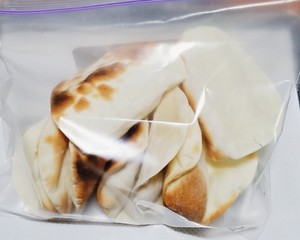So Delicious! Mexican Chicken Roll (dumpling Skin Version)
1.
Put the seasoning marked a in a container, stir well, and make a sauce for later use. (Adjust the amount of chili powder and salt according to your taste)
Wash the lettuce and cabbage and cut into thin strips for later use.
Mash the ripe avocado, add the seasoning marked b, mix well and set aside. (If you don’t like it, don’t let it go)
Remove the juice from the slightly firmer tomatoes, cut into cubes, add the seasoning marked c, and mix well for later use.
2.
Peel the onion, wash, and cut into cubes for later use.
Pour 1 tablespoon of vegetable oil into the pot. After the oil is boiled, pour in the diced onion and stir fry until transparent.
Pour in the minced chicken breast and stir fry until the color changes.
Pour in the sauce, shovel the minced meat with a stir-frying spatula. The whole process needs a medium-to-low heat. Fry until the juice is collected and turn off the heat.
3.
This is an aluminum foil paper core (the diameter of the core matches the diameter of the dumpling wrapper very well.) Roll the aluminum foil paper onto the paper core. Both ends of the paper core should also be tightly wrapped with aluminum foil. Put the dumpling wrapper on top, leaving a slight gap between the bottom of the dumpling wrapper and the cutting board.
4.
If you don't have an aluminum foil paper core, you can also use baked oil paper rolls instead. Wrap the aluminum foil paper on the greased paper, paying attention to the aluminum foil paper on both ends. (🌸To make a total of three aluminum foil rolls, the length is basically the same as the length of the soil driver)
5.
Put two dumpling wrappers on each roll of aluminum foil. (There are 3 sticks in total, and 6 dumpling wrappers can be baked at a time.)
Put it in a local driver (my local driver is 1000W), and bake for about 2 minutes. The top is easy to burn. When the upper part starts to be colored, remove the dumpling wrapper from the aluminum foil roll. If the sides of the dumpling wrapper are not cooked, turn the dumpling wrapper over and continue to bake for 10-20 seconds until the dumpling wrapper bulges on both sides. )
(🌸The soil driver mentioned here may be a domestic simple oven! But Japan does use it to bake toast slices with bacon and cheese on top🌸)
6.
Use bread tongs to move aluminum foil rolls during operation to prevent burns to your hands.
7.
This is the baked dumpling skin, very crispy.
8.
If you don't have a local driver, fold an appropriate amount of aluminum foil together. Pour a small amount of oil into the pot. Fold the dumpling wrapper in half and clamp the aluminum foil. Boiled in a small fire. Turn over and burn the other side after coloring on one side.
9.
This is dumpling wrappers baked in a frying pan.
10.
Take out a baked dumpling wrapper, add appropriate amount of vegetables, spread guacamole, add minced chicken breast and diced tomatoes.
11.
According to taste, sprinkle with a small amount of casein is more delicious.
12.
Eat leftover dumpling skins and put them in a fresh-keeping bag to keep them for 3-5 days)


Tips:
1. The skin of the dumplings used should not be too thin, otherwise it will break easily after being baked. Generally, the thickness of the dumpling skin when making dumplings at home is fine. The diameter of dumpling wrapper for adults is about 8 to 8.5 cm, and the diameter of dumpling wrapper for children is about 6 to 7 cm.
2. The aluminum foil paper rolls that are only rolled out of aluminum foil paper are very light, and the dumpling wrappers will expand when heated, causing the aluminum foil rolls to move, and the dumpling wrappers will easily fall off.
3.3 pieces of aluminum foil paper are put together and baked to prevent the dumpling skin from slipping off. However, the dumpling skin is not evenly heated, and the lower end may be in a half-life state. You need to remove the aluminum foil paper roll, turn the lower end of the half-raw dumpling skin up, and continue to bake for 10-20 seconds to ensure the crispy taste of the finished product.
4. Use the bread clip to move the aluminum foil paper roll during operation to prevent burns to your hands.